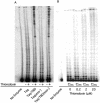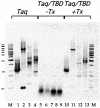Insertion of the T3 DNA polymerase thioredoxin binding domain enhances the processivity and fidelity of Taq DNA polymerase
- PMID: 12907710
- PMCID: PMC169918
- DOI: 10.1093/nar/gkg667
Insertion of the T3 DNA polymerase thioredoxin binding domain enhances the processivity and fidelity of Taq DNA polymerase
Abstract
Insertion of the T3 DNA polymerase thioredoxin binding domain (TBD) into the distantly related thermostable Taq DNA polymerase at an analogous position in the thumb domain, converts the Taq DNA polymerase from a low processive to a highly processive enzyme. Processivity is dependent on the presence of thioredoxin. The enhancement in processivity is 20-50-fold when compared with the wild-type Taq DNA polymerase or to the recombinant polymerase in the absence of thioredoxin. The recombinant Taq DNA pol/TBD is thermostable, PCR competent and able to copy repetitive deoxynucleotide sequences six to seven times more faithfully than Taq DNA polymerase and makes 2-3-fold fewer AT-->GC transition mutations.
Figures







Similar articles
-
A novel strategy to engineer DNA polymerases for enhanced processivity and improved performance in vitro.Nucleic Acids Res. 2004 Feb 18;32(3):1197-207. doi: 10.1093/nar/gkh271. Print 2004. Nucleic Acids Res. 2004. PMID: 14973201 Free PMC article.
-
The thioredoxin binding domain of bacteriophage T7 DNA polymerase confers processivity on Escherichia coli DNA polymerase I.Proc Natl Acad Sci U S A. 1997 Jan 21;94(2):479-84. doi: 10.1073/pnas.94.2.479. Proc Natl Acad Sci U S A. 1997. PMID: 9012809 Free PMC article.
-
Error-prone replication of repeated DNA sequences by T7 DNA polymerase in the absence of its processivity subunit.Proc Natl Acad Sci U S A. 1994 Jul 19;91(15):6830-4. doi: 10.1073/pnas.91.15.6830. Proc Natl Acad Sci U S A. 1994. PMID: 8041704 Free PMC article.
-
[Polymerase chain reaction, cold probes and clinical diagnosis].Sante. 1994 Jan-Feb;4(1):43-52. Sante. 1994. PMID: 7909267 Review. French.
-
DNA polymerase fidelity and the polymerase chain reaction.PCR Methods Appl. 1991 Aug;1(1):17-24. doi: 10.1101/gr.1.1.17. PCR Methods Appl. 1991. PMID: 1842916 Review.
Cited by
-
Speeding up biomolecular interactions by molecular sledding.Chem Sci. 2016 Feb 1;7(2):916-920. doi: 10.1039/C5SC03063C. Epub 2015 Oct 7. Chem Sci. 2016. PMID: 26913169 Free PMC article.
-
The core oligosaccharide and thioredoxin of Vibrio cholerae are necessary for binding and propagation of its typing phage VP3.J Bacteriol. 2009 Apr;191(8):2622-9. doi: 10.1128/JB.01370-08. Epub 2009 Feb 6. J Bacteriol. 2009. PMID: 19201789 Free PMC article.
-
Two Approaches to Enhance the Processivity and Salt Tolerance of Staphylococcus aureus DNA Polymerase.Protein J. 2019 Apr;38(2):190-198. doi: 10.1007/s10930-019-09818-7. Protein J. 2019. PMID: 30759302 Free PMC article.
-
Engineering human PrimPol into an efficient RNA-dependent-DNA primase/polymerase.Nucleic Acids Res. 2017 Sep 6;45(15):9046-9058. doi: 10.1093/nar/gkx633. Nucleic Acids Res. 2017. PMID: 28911121 Free PMC article.
-
DNA Polymerases for Whole Genome Amplification: Considerations and Future Directions.Int J Mol Sci. 2023 May 26;24(11):9331. doi: 10.3390/ijms24119331. Int J Mol Sci. 2023. PMID: 37298280 Free PMC article. Review.
References
-
- Sia E.A., Jinks-Robertson,S. and Petes,T.D. (1997) Genetic control of microsatellite stability. Mutat. Res., 383, 61–70. - PubMed
-
- Kunkel T.A. and Alexander,P.S. (1986) The base substitution fidelity of eucaryotic DNA polymerases. Mispairing frequencies, site preferences, insertion preferences and base substitution by dislocation. J. Biol. Chem., 261, 160–166. - PubMed
-
- Himawan J.S. and Richardson,C.C. (1996) Amino acid residues critical for the interaction between bacteriophage T7 DNA polymerase and Escherichia coli thioredoxin. J. Biol. Chem., 271, 19999–20008. - PubMed
-
- Tabor S., Huber,H.E. and Richardson,C.C. (1987) Escherichia coli thioredoxin confers processivity on the DNA polymerase activity of the gene 5 protein of bacteriophage T7. J. Biol. Chem., 262, 16212–16223. - PubMed
-
- Huber H.E., Tabor,S. and Richardson,C.C. (1987) Escherichia coli thioredoxin stabilizes complexes of bacteriophage T7 DNA polymerase and primed templates. J. Biol. Chem., 262, 16224–16232. - PubMed
Publication types
MeSH terms
Substances
Grants and funding
LinkOut - more resources
Full Text Sources
Other Literature Sources
Miscellaneous

